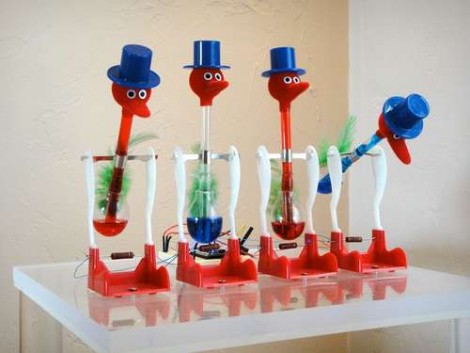
This Dippy Bird clock display is simple to build and it’s just waiting to be scaled up for use as a full clock. As shown there are only enough birds in this rendition to read out the hours. More tiers can be added for minutes and you could even add your own temperature readout function using a separate bird as the thermometer.
Other than the fact that there are only four bits of resolution, the first thing you should notice is that these birds have nothing to drink. They’re intended to dip their beaks into a glass of water, leading to evaporation that changes the temperature of the dichloromethane inside to start their teeter-tottering. Water isn’t used because the birds would be in constant motion. Instead a resistor has been placed in the base of each, which heats up when current is passed through it. A bird in motion is a digital 1, and bird at rest is a digital 0. A set of transistors protects the microcontroller from sourcing too much current. In this case an mbed is keeping time but any microcontroller will do. We’ve embedded a quick clip of the dippy bird clock after the break.
[youtube=http://www.youtube.com/watch?v=-WRgB_GITY0&w=470]















Nice idea. You could use the 4 bits available to display both the hours and minutes in binary coded decimal. For example –
Play a start of sequence pattern
Send Hour high digit
Send Hour low digit
Send Minute high digit
Send Minute low digit
Repeat
Start sequence could be some kind of funky synchronised nodding display.
And when you finished decoding the time, you need to read it again :)
This is surely going to be the next optical digital communication standard! :D
Neat but kinda wobbly, he should try magnets in the birds base and and electromagnets to attract and repell them, that might make them a bit stabiler. Oh yea and when he upgrades to a full clock different coloured bird bums for the hours and minutes.
Magnets? I’m sorry but that’s stupid. The whole point was hacking the bird’s mechanism of motion by removing the water source and replacing it with a heat source. You lose the spirit of the hack if you add magnets, then there is no point of using a drinking bird.
oh there are so many better ways to produce heat than to dump it though a resistor.
Really? Care to give a few examples? I’m seriously actually because I’ve been messing around with power resistors the past few weeks working on a small project and I actually thought it was pretty efficient.
nichrome wire :D
Wow, really bad video, you cant even see the operation well. I really hope he finds a friend that knows how to use the video camera and at least runs a test program to show the cycling of the birds.
“Hmmm… Now where’s my Tab???”
/couldn’t resist :)